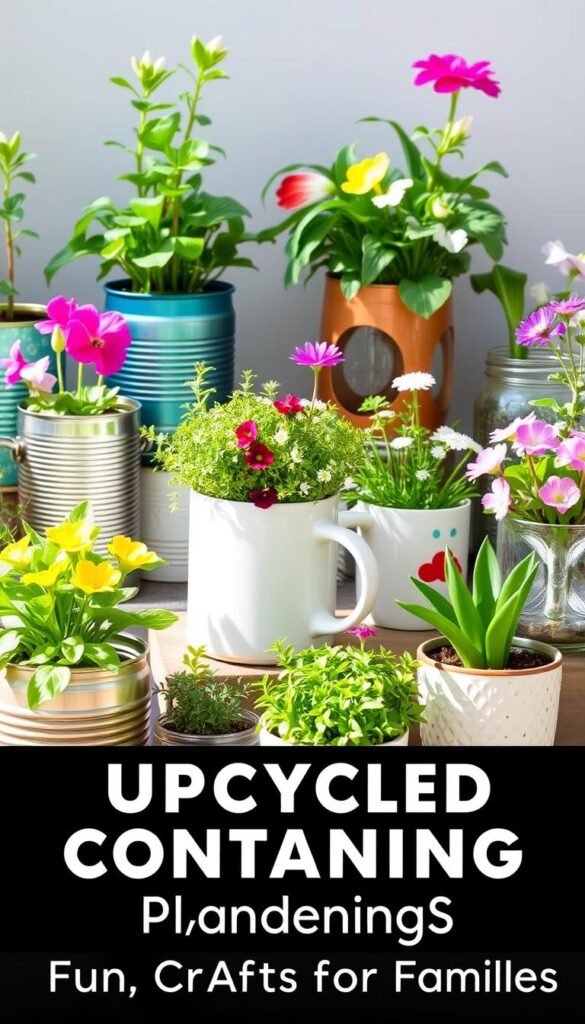What if your empty pasta jars or worn-out boots could become homes for vibrant blooms? Repurposing household items as planters lets you blend creativity with sustainability. This approach turns ordinary objects into eye-catching displays while keeping materials out of landfills.
You don’t need fancy supplies to start. A cracked teapot or unused kitchen colander can become a charming home for herbs. Even young ones can join in—painting old cans or arranging flowers in mismatched mugs becomes a bonding activity that sparks curiosity about nature.
Choosing this method supports eco-conscious habits. Every reused item means one less piece of plastic or ceramic in recycling centers. Plus, it adds personality to patios or windowsills—imagine colorful succulents thriving in retro lunchboxes!
Ready to dive in? We’ll walk through simple projects using items already in your home. From selecting the right soil to pairing plants with containers, you’ll discover how easy it is to create living art. Let’s turn “trash” into treasure while making memories with your crew.
Getting Started with Upcycled Container Gardening
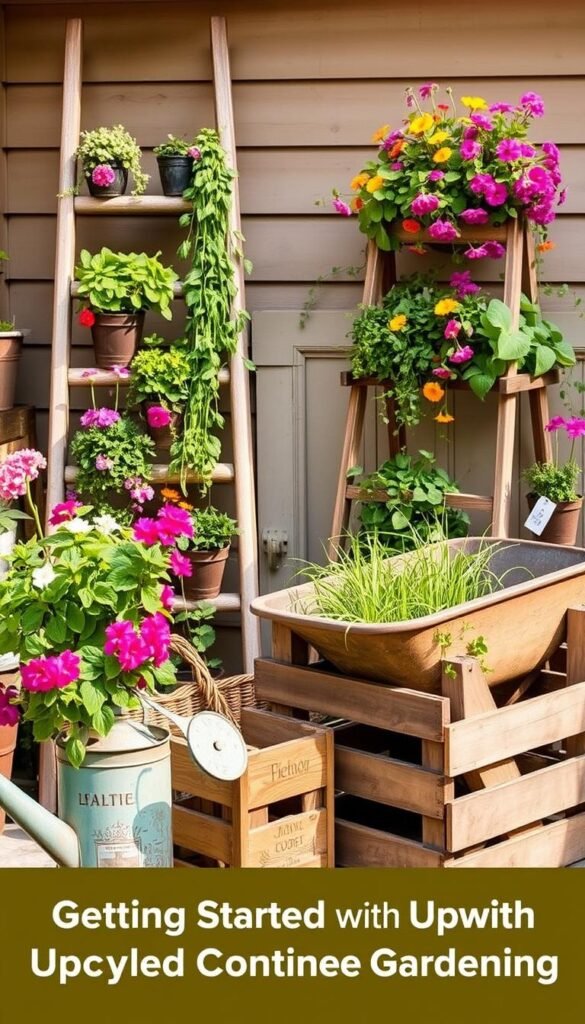
Your next planter might be hiding in the recycling bin right now. By reimagining everyday objects, you can create a thriving green space while reducing waste. This hands-on method turns clutter into functional art—and it’s simpler than you think.
Why Repurposing Works for Green Spaces
Transforming milk jugs into herb pots or yogurt cups into seedling starters keeps plastic out of landfills. Projects like these, inspired by Red Ted Art, show how creativity meets sustainability. You’ll save money on store-bought pots and give your yard a one-of-a-kind look.
Finding Hidden Treasures at Home
Start by collecting:
- Tin cans (perfect for succulents)
- Glass jars (ideal for propagating cuttings)
- Plastic bottles (great for drip irrigation)
Coffee Cups and Crayons suggests letting kids decorate these items with paint or stickers. A painted soup can becomes a cheerful home for marigolds, while a colander doubles as a hanging basket. The best part? You’re teaching younger generations eco-friendly habits through play.
Upcycled Container Gardening: Fun Crafts for Families
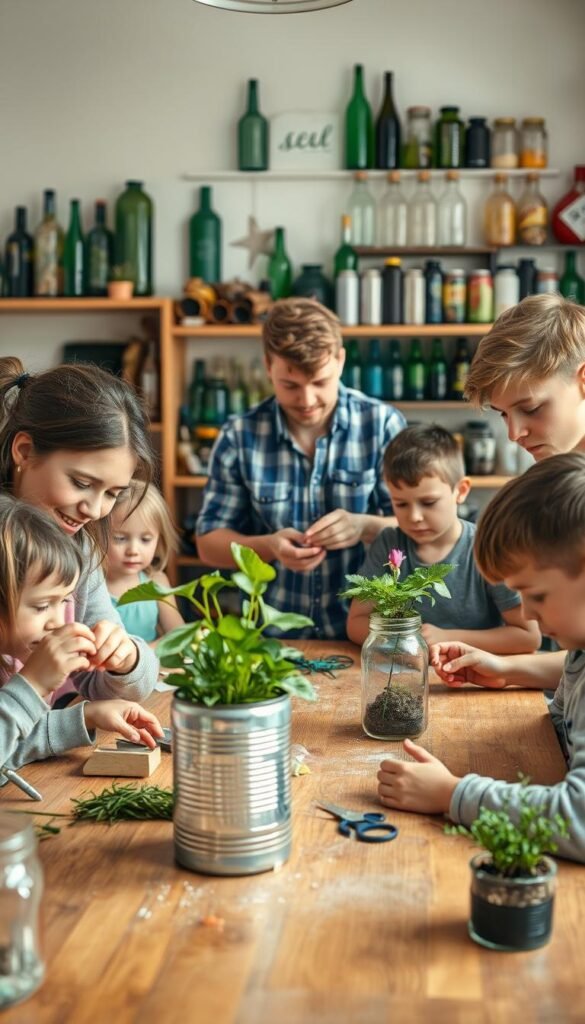
Imagine transforming a soda bottle into a whimsical planter with your kids. This hands-on activity turns ordinary household items into lively green spaces while teaching eco-friendly values. The process sparks curiosity—children love watching seeds sprout in their decorated creations.
Empty tin cans become herb gardens with a coat of paint. Plastic milk jugs morph into hanging planters for strawberries. These simple ideas turn your kitchen’s recycling bin into a goldmine for creative garden projects. Even mismatched mugs can host cheerful blooms!
| Project | Materials | Benefits |
|---|---|---|
| Soda Bottle Planter | Plastic bottle, scissors, soil | Teaches water conservation |
| Tin Can Herb Garden | Cans, acrylic paint, herbs | Fresh flavors for meals |
| Boot Flower Pot | Old footwear, drainage rocks | Unique yard decoration |
This approach makes gardening accessible—no yard required. A windowsill becomes a jungle of basil and mint. Check out vibrant flowers that thrive in small spaces. Let kids pick colors for painted pots or arrange pebbles for drainage.
The best part? You’re building memories while reducing waste. A cracked teapot housing succulents tells a story. Every project becomes a shared victory—proof that sustainability can be joyful and uncomplicated.
Choosing Creative Containers and Essential Materials
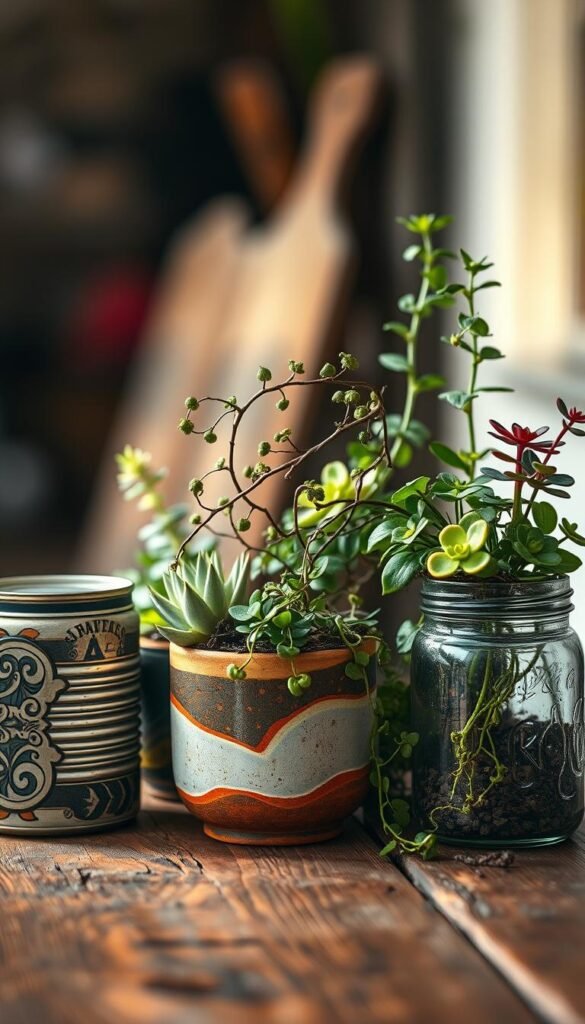
Your kitchen drawer might hold the secret to a thriving herb garden. From vintage toolboxes to wine glasses, everyday items can become unique homes for plants. The key is balancing practicality with personality.
Exploring Unique Reusable Items from Around the Home
Look for objects with interesting shapes or textures. A muffin tin becomes a mini succulent display, while a wooden crate transforms into a rustic planter for pansies. Even cracked ceramics work—drill holes in the bottom, and they’re ready for basil or thyme.
What to Look for in Containers & Tools: Drainage, Size, and Style
Always check for drainage potential. No holes? Use a hammer and nail to create them. Shallow containers suit herbs like oregano, while deeper ones support tomato seedlings. For inspiration, see these clever solutions using household materials.
| Container Type | Best For | Prep Tip |
|---|---|---|
| Plastic Bottles | Trailing flowers | Cut sideways for horizontal growth |
| Tin Cans | Small herbs | Sand sharp edges |
| Colanders | Strawberries | Line with coconut fiber |
Personalize your finds with chalk paint or decoupage. A colorful milk jug or patterned teacup adds charm to patios. Remember: functionality meets fun when you rethink ordinary objects.
Step-by-Step Guide to Crafting Your Garden Planters
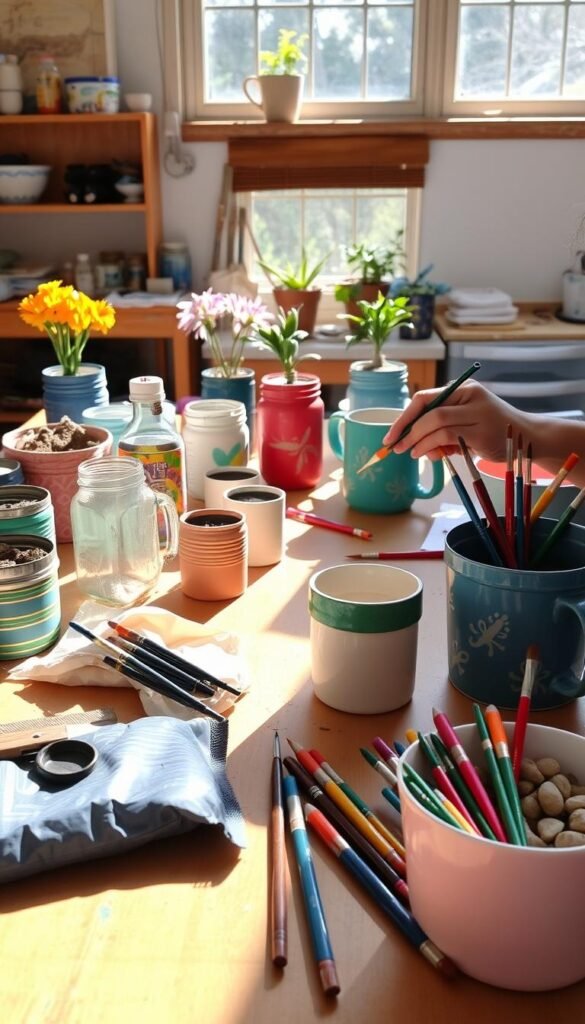
Have you ever looked at a cereal box and seen a future herb garden? Transforming everyday items into planters requires just three key steps: preparation, creativity, and care. Let’s break down how to turn cardboard, plastic, and glass into thriving homes for your plants.
Preparing Your Containers for Planting
Start by cleaning items thoroughly. Scrub old jars with soapy water to remove residue. For cardboard egg cartons or newspaper pots, skip washing—they’ll decompose naturally.
Next, create drainage holes. Use a drill for glass jars or scissors for milk cartons. Always puncture the bottom—this prevents water from pooling around roots. Test by pouring a cup of water through; it should flow freely.
Simple DIY Techniques for Painting and Decorating
Seal porous materials like wood with non-toxic primer. Let kids use acrylic paint to add stripes or polka dots to tin cans. Try these ideas:
- Wrap juice cartons in burlap for rustic charm
- Glue buttons onto plastic containers
- Stencil herb names on newspaper pots
| Material | Preparation | Best For |
|---|---|---|
| Cardboard Boxes | Line with plastic wrap | Leafy greens |
| Glass Bottles | Add pebble layer | Succulents |
| Plastic Tubs | Drill side holes | Trailing vines |
Make sure each planter has proper airflow. Loose soil mixes work best for most plants. For deeper guidance, explore container gardening basics. Now grab those spare mugs and let your green thumb shine!
Making It Fun: Engaging Kids in Gardening Crafts

Transform rainy afternoons into creative adventures by merging art with nature. Hands-on projects let young minds explore textures, colors, and growth cycles while repurposing household items. A yogurt cup becomes a seedling starter, and old rain boots turn into quirky planters—endless possibilities await!
Fun Craft Projects that Involve the Whole Family
Start with simple ideas like painting tin cans for herb gardens. Red Ted Art recommends using egg cartons as biodegradable seed trays—kids can label each section with stickers. Try these crowd-pleasers:
- Decorate mismatched mugs with acrylic paint for succulents
- Turn plastic bottles into hanging strawberry pots
- Transform shoeboxes into mini vegetable patches
Using Recycled Materials to Spark Creativity in Children
NurtureStore suggests letting children choose items from your recycling bin. A cereal box? Perfect for growing microgreens. A cracked teapot? Ideal for trailing ivy. This approach teaches resourcefulness while reducing waste.
| Project | Materials Needed | Skills Learned |
|---|---|---|
| Painted Can Herb Pots | Cans, non-toxic paint | Color mixing, plant care |
| Egg Carton Seed Starters | Cartons, soil, seeds | Patience, responsibility |
| Bottle Cap Labels | Plastic caps, markers | Organization, creativity |
Pair these activities with budget-friendly container gardening tips to maximize savings. Let each family member design their own planter—you’ll create lasting memories while nurturing green habits.
Budget-Friendly and Sustainable Upcycling Tips
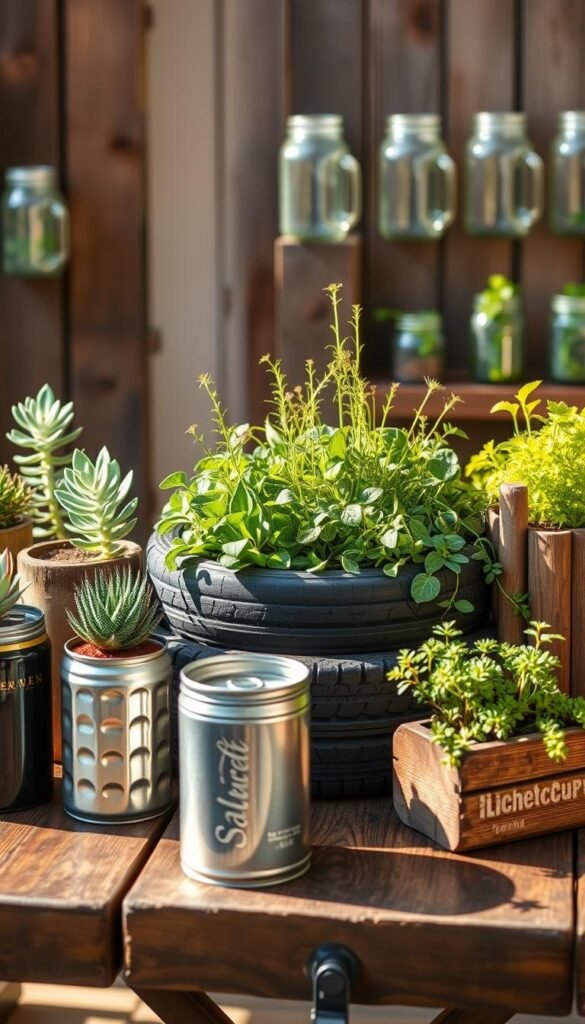
Your home is full of hidden gems waiting to become plant homes. With a little ingenuity, items like tin cans and shopping bags can thrive as stylish, earth-friendly planters. These projects keep your wallet happy while reducing waste—no fancy tools required.
Repurposing Everyday Items to Save Money
Turn grocery bags into grow sacks for potatoes or carrots—just poke holes in the bottom for drainage. Old boots? They’re perfect for shallow-rooted flowers like pansies. Even cracked mixing bowls can host herbs if you layer pebbles beneath the soil.
| Project | Materials | Cost Savings |
|---|---|---|
| Tin Can Herb Pots | Cans, sandpaper, paint | $0 (vs. $5 store pots) |
| Shopping Bag Grow Bags | Reusable bags, scissors | Up to $15 saved |
| Boot Planters | Old footwear, rocks | Free alternative to ceramic |
Maintaining a Green and Healthy Container Garden
Always prioritize airflow and water control. Use a screwdriver to create drainage holes in plastic tubs or wooden crates. Line the bottom with coffee filters to prevent soil loss. For nutrient-rich soil, mix compost with leftover coffee grounds.
Rotate plants weekly for even sun exposure. Swap pricey fertilizers with banana peel tea—soak peels in water for three days, then feed your greens. Learn more about eco-friendly container gardening to maximize sustainability.
With these tips, your space becomes a thriving oasis without breaking the bank. Every repurposed item tells a story—and keeps your garden green in more ways than one.
Final Thoughts on Your Upcycled Gardening Journey
That empty jam jar sitting in your cabinet? It’s a future herb haven waiting to happen. By transforming everyday items into containers, you’ve discovered how creativity meets sustainability. Whether painting pots or drilling drainage holes, each step builds eco-friendly habits that benefit both your home and the planet.
Remember to make sure every repurposed item supports healthy plants. Proper drainage, quality soil, and sunlight turn quirky containers into thriving ecosystems. A painted tin can or retro colander becomes more than a planter—it’s a conversation starter that reduces waste.
Engaging loved ones in these projects strengthens bonds while teaching green values. Even simple tasks like arranging pebbles or choosing paint colors spark joy and curiosity. Together, you’re crafting more than a garden—you’re nurturing lasting memories.
Keep experimenting! Swap materials, try new plants, or redesign pots as seasons change. Every small effort adds up, proving that sustainability can be vibrant, affordable, and deeply rewarding. Your journey doesn’t end here—it’s just beginning.

